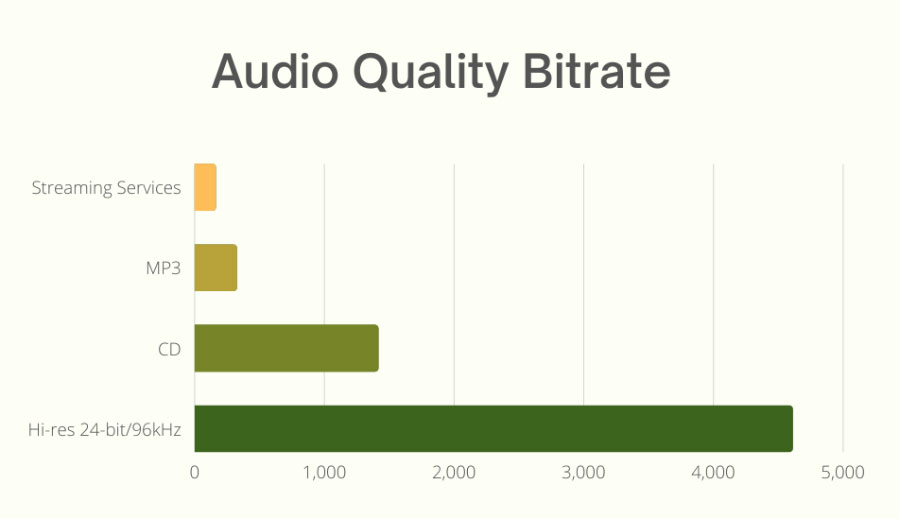Table of Contents:
What is audio?
Audio is sound within the acoustic range available to humans. An audio frequency (AF) is an electrical alternating current within the 20 to 20,000 hertz (cycles per second) range that can be used to produce acoustic sound.
In computers, audio is the sound system that comes with or can be added to a computer. The most common type of audio file format used today is MP3.
What is the difference between audio and sound?
Sound is vibrations through materials or medium, it's the energy that travels through a medium or a substance as sound frequency waves. Audio is a description of what we hear from digital or human-made sources.
What is audio quality?
This is an assessment of the accuracy, fidelity, or intelligibility of audio output from an electronic device. Audio can be measured both objectively and subjectively.
What determines audio quality?
The quality of a digital audio recording depends heavily on two factors: the sample rate and the sample format or bit depth. Increasing the sample rate or the number of bits in each sample increases the amount of space used by audio files on a computer or disk.
What factors affect audio quality?
This depends on a number of factors, including the equipment used to make it, the processing and mastering done to the recording, the equipment that is used to reproduce it, and the listening environment used to reproduce it.
What is the standard audio quality?
Audio CD bitrate is always 1,411 kilobits per second (Kbps). The MP3 format can range from around 96 to 320Kbps, and streaming services like Spotify range from around 96 to 160Kbps. High bitrates appeal to audiophiles, but they are not always better.

What does bitrate mean?
In telecommunications and computing bitrate is the number of bits that are conveyed or processed per unit of time.
What is the best bitrate?
There is no right or wrong answer to this question, however, we should be asking what is the ideal bitrate for what I need. The right bitrate for a file will depend on what you want to use the file for and the means of delivering the audio. Generally speaking, a high bitrate means high-quality audio, provided the sample rate and bit depth are also high. More information, in a very general sense, means better sound quality.
What is the best audio quality?
Generally speaking the highest quality MP3 has a bitrate of 320kbps, whereas a 24-bit/192kHz file has a data rate of 9216kbps. Music CDs are 1411kbps. The hi-res 24-bit/96kHz or 24-bit/192kHz files should, therefore, more closely replicate the sound quality the musicians and engineers were working with in the studio.
What is the best audio quality setting?
For music, 64 (AAC)/96 (MP3) kbps is a good general-purpose setting that will sound good to most listeners. This is the standard bitrate for a podcast and it will sound great on most contemporary devices, including smart speakers and mobile devices.
How can I improve audio quality?
- Choose the right recording equipment and software for you.
- Find the right place to record and ensure outside noise is kept to a minimum.
- Speak near the microphone; this will ensure a better sound.
- Make sure to use a pop filter as this will prevent audio distortion.
- Select the right audio interface for what you need.
- Edit and produce your content.
- Always make sure you backup your recordings.
Does YouTube lower audio quality?
All audio on YouTube is compressed to approximately 126 kbps AAC. AAC compression sounds ok at quite low bitrates.
How can I fix the sound quality on YouTube?
Select or Change your Audio Quality
- In the YouTube Music app, tap on your profile picture.
- Select Settings.
- Tap Playback & restrictions.
- Tap Audio quality on Wi-Fi.
- Select one of the available options:
- Low. Uses the least data. Upper bound of 48kbps AAC.
- Normal. Default setting. Upper bound of 128kbps AAC.
- High. Please be aware that this will use extra data.
How can I improve audio quality in Audacity?
To do this, use these 8 steps below:
- Use the Noise Profile.
- Use the Normalizer.
- Use the Compressor.
- Use the Equalizer.
- Use Spectrogram.
- Use the AutoDuck effect.
- Use Bass and Treble Boost.
- Combine Audacity and Krisp for the perfect audio production.
Does Spotify have high-quality audio?
Spotify delivers music in CD quality, lossless audio format to your device and Spotify connect-enabled speakers meaning you enjoy more depth and quality on your favourite tracks.
Which streaming service has the best quality audio?
Tidal is the music streaming service with the best quality sound. Tidal brings users a lossless audio experience.

Which is the best quality audio format?
A lossless audio file format is the best format for sound quality. These include FLAC, WAV, or AIFF. These types of files are considered “hi-res” because they are better or equal to CD quality. The trade-off is that these files will be very large.
How do I check audio quality?
The best way to do this is to run a spectrum analysis. This will measure the power and magnitude of an input signal versus frequency.
How do you measure audio quality?
Audio Quality is extremely complicated and cannot be measured and analysed using just numbers. It is important to remember that volume does not equal quality.
There are many ways to measure sound quality. Most of the methods that have been developed for this purpose not only measure quality but also provide easy-to-understand ratings for different sound quality metrics. Here are a few of the most common types of measurements used for sound quality.
THD (Total Harmonic Distortion)
It is a measurement taken to view the total amount of distortion from the original audio signal at playback. Most quality components have less than 1% distortion rate, loudspeakers can have a 1 to 5% distortion rate and bass subwoofers can produce the most distortion, sometimes approaching 10%. However, human ears can't differentiate distortion at very low bass levels.
Output Power
Output power is the maximum energy per channel, usually shown as Watts. Most speakers or receivers show the number of watts that they have. There are two measurements: peak and RMS. Peak watts are usually what is shown in advertisements, it is usually the maximum amount of energy that a speaker or receiver can give off for a very short period of time. RMS stands for Root Means Square and is a more appropriate way to determine power over a longer period of time.
Frequency Response
Frequency Response is an important way to determine the quality of sound. Most human ears can hear a frequency (sound) that is from about 20 Hz to about 20K Hz. Bass forms the lower parts of the Frequency response spectrum. Most people consider bass frequencies, those frequencies below 310 Hz. Bass frequencies include percussion and explosions from movie DVDs. Midrange frequencies are those frequencies that range from about 310 Hz to about 12K Hz. These frequencies include dialogue and most of the human voice, piano, guitar and other instruments. High frequencies are at the top of the frequency response spectrum. They are usually from 12K to about 20K or higher. They include cymbals, high notes from the human voice, and some string instruments.
Signal to Noise Ratio
Signal to noise ratio is the ratio of quality sound to noise. This measurement is used to measure many devices including receivers, CD players, DVD players, etc. Usually the higher the decibel (Db), the better the quality of sound. For instance, a signal-to-noise ratio of 90 or 100 decibels is considered high fidelity. Most electronics are usually 80 decibels or over which is great for many discerning human ears.
It is important to note that the above terms are not the only way to measure sound. There are various ways to measure sound, components and media which are either digital or analogue. However, knowing about the above terms does give you some insight into the process of measuring sound quality.

 Hate
Hate
 Dislike
Dislike
 Neutral
Neutral
 Like
Like
 Love
Love





















